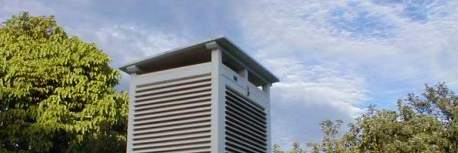

Current weather forecasts normally don't give enough detail. For example, they indicate showers of rain of the same proportion irrespective of whether the chance is high or extremely low. A better way to give the public a greater understanding of expected weather would be to state more categories indicating the chance of an event. This would save many people ringing the weather bureau for a specific forecast and hence save the bureau's staff time. Instead the bureau could spend time providing accurate forecasts for everybody like in the examples below.
Currently in this area only two categories are used to describe showers. They are classed as either isolated or scattered. A better way would be to state the chance of showers is either very high, high, moderate, low or very low. It would also be good to give an approximate idea of the probability of an event occurring and how pronounced the event will be. There are times when the weather is very predictable and the forecast certainty can be high, but other times like near a cyclone the forecast certainty would be low. It would therefore also be important to indicate the estimated certainty that the forecast will be correct. Below is an example for the chance of rainfall for two separate days for a particular location. An estimate of the chances of different amounts of rain falling is also given.
Rainfall: (mm)
Rainfall: (mm)
Forecasts for other measurements should also be added to give the public a better idea of what the weather will be like in their area. Knowledge of cloud cover is important for photography or to determine how severe a problem the sun will be. For example, some days cause severe sunburn or damage to sensitive equipment that is temporarily left outside or transported. If you have to transport heat sensitive equipment in an ordinary vehicle it would be better to choose a cloudy but fine day. This is because the temperature on surfaces exposed to the sun is often 20 degrees Celsius warmer than the shade temperature when the sun is shining. The shade temperature changes nowhere near as much. Also knowing the cloud cover would increase the safety for flying or navigation.
An example of a days cloud cover forecast is below. It also contains the expected cloud types
Cloud cover: (8ths)
Visibility is important for photography, sight seeing, flying and bush walking because it is better to choose a clear day for a better view. Tourism operators could focus more on the activities without views when the visibility is not forecast to be high. They could do activities that reveal the spectacular views on days that are forecast to be clear. This would encourage more tourists to come and return.
Also a lack of visibility forecasts can cause safety problems for navigation and flying.
Generally visibility readings indicate how far away you can see an object clearly. The highest reported reading is 50km. However, many people would be able to see a lot further than that. Often mountains can be seen over 120km away. An example of the visibility forecast on a given day would be
Visibility: 40-50km in AM. 20-30km in PM
Forecast for other measurements such as temperature and wind could be forecast like below.
Temp: Min 17 Max 31
Wind: SE 10-15 knots
A forecast for a location for all the above variables could simply be printed in a small space by using abbreviations such as FC for forecast certainty.
An example is below.
Low chance of late afternoon convective shower
Cloud: Cu 1-3 in AM. Cu & Cb 4-6 in PM
Visibility: 40-50km in AM. 20-30km in PM
Temp: Min 17 Max 31
Wind: SE 10-15 knots
More research should be done on forecasting using different methods. They could include studying repeated patterns such as synoptic charts, rainfall and temperature trends, lunar phases and the behavior of plants and animals such as ants.
If more volunteers would spend time to stay in tune with these things forecasts could be improved dramatically. I have noticed patterns but the lack of time prevents me from doing more research and observing these variables.
High chance of early afternoon convective shower.
0< 70%, 1< 50%, 5< 30%, 20< 5%
Forecast certainty = 70%
Low chance of late afternoon convective shower
0< 10%, 1< 2%, 5< 0.5%, 20< 0.05%
Forecast certainty = 90%
Cu 1-3 in AM. Cu & Cb 4-6 in PM
Forecast certainty = 90%
Forecast certainty = 70%
Forecast certainty within 2 degrees = 70%
Forecast certainty = 80%
0mm<10%, 1mm<2%, 5mm<0.5%, 20mm<0.05%
FC = 90%
FC = 90%
FC = 70%
FC within 2 degrees = 70%
FC = 80%
![]() Please make sure you have seen the Worldwide Weather Organization with
High Quality Detailed Graphs.
Please make sure you have seen the Worldwide Weather Organization with
High Quality Detailed Graphs.
Links to other weather related sites
|
|